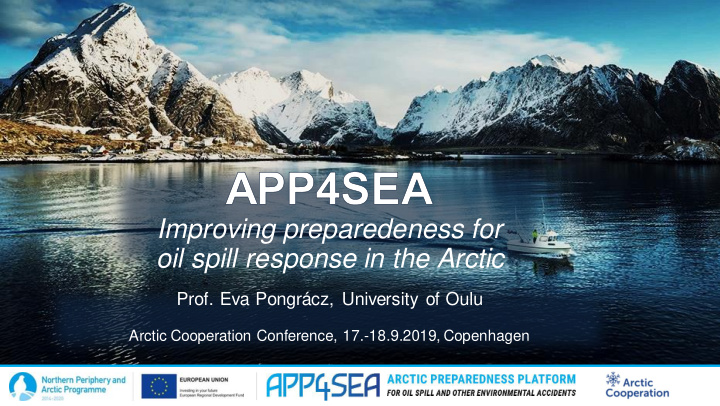



Improving preparedeness for oil spill response in the Arctic Prof. Eva Pongrácz, University of Oulu Arctic Cooperation Conference, 17.-18.9.2019, Copenhagen
Arctic Preparedness Platform for Oil Spill and other Environmental Accidents (2017-2020) • Objectives • Sharing best practices on Arctic oil spill response (OSR) methods and technologies considering the ecological vulnerability of the Arctic • Cross-border collaboration in OSR • Raise awareness of local authorities and communities of oil spill risks • Create an open access smart map and interactive educational materials • Funded by the Northern Periphery and Arctic Programme 2014-2020 (and the project partners) • Partners from Finland, Norway, Iceland and Scotland 2
APP4SEA partners and marine areas in our interest Sea area of interest: ~ 5,2 million km 2 Barents Sea Land area of EU: - 4,476 M km 2 Norwegian Sea North Atlantic North Sea 3
What app for sea? Interactive website : Map : To be aware of trends, OSR centres risks and readiness levels Ship movements Weather zones Infographics : Seabird vulnerability To visualize info for educational purposes Database : Simulations and data Case studies Animations and demos : on oil behaviour in Simulations To visualize accidents cold waters OpenDrift : Reports and their impacts Access to Ocean Social Useful links trajectory model media posts 18.09.2019 4
The APP4SEA map Oil spill response sites and simulated drift models Ecologically Animations sensitive areas 5
The Arc rcti tic ma mari rine aspect • Multiple stressor and their cumulative impacts • Climate change impacts • The Arctic is warming twice as fast at the rest of the planet • Ocean acidification is closing critical levels • Levels are higher in Arctic seas than globally • A major pollution concern is marine plastics • Artic Ocean is a dead end of floating plastics • Pollution from ships, coastal activities, oil & gas • Short term climate forcers, such as black carbon and methane are also gaining attention • Far too little is known about Arctic biodiversity, in terms of marine ecosystems • Loss of habitat/sea ice decline • Northward shifting of Arctic species 6 6 18.9.2019
The Arctic: Bottom-up vs. top-down • The Arctic is vast • Problems transboundary in nature • Understanding Arctic change requires a systemic perspective that integrates human and natural dynamics • Transnational and transdisciplinary cooperation is indispensable 7 18.09.2019
Me Messages fro rom m APP4SEA • Challenges of the Arctic • The state of the Arctic environment indicates deepening unsustainability • Cumulative impacts from several stressors are inhibiting the ability of ecosystems to resist and recover • What can we learn from the Arctic? • The Arctic seas unite, cooperation of Arctic nations and communication across sectors is necessary • We scale and pace of change is unprecedented, we need to act fast, adaptation and mitigation in parallel • The importance of collaboration • Cooperation of research, environmental authorities and regional governance ensures that competing needs and interests are taken into consideration • Based on sound science, sharing best practices, action rooted in local communities • This would not have been achieved without the funding of the NPA Programme • Benefits to local communities • Ultimately, our major stakeholders and major beneficiaries are the people of Arctic communities • The issue at hand is the future of these communities; raising awareness and communication are key 8 18.09.2019
Thank you! APP4SEA_NPA www.facebook.com/APP4SEA/ www.linkedin.com/company/app4sea/ http://app4sea.interreg-npa.eu/ 9 18.09.2019
Recommend
More recommend